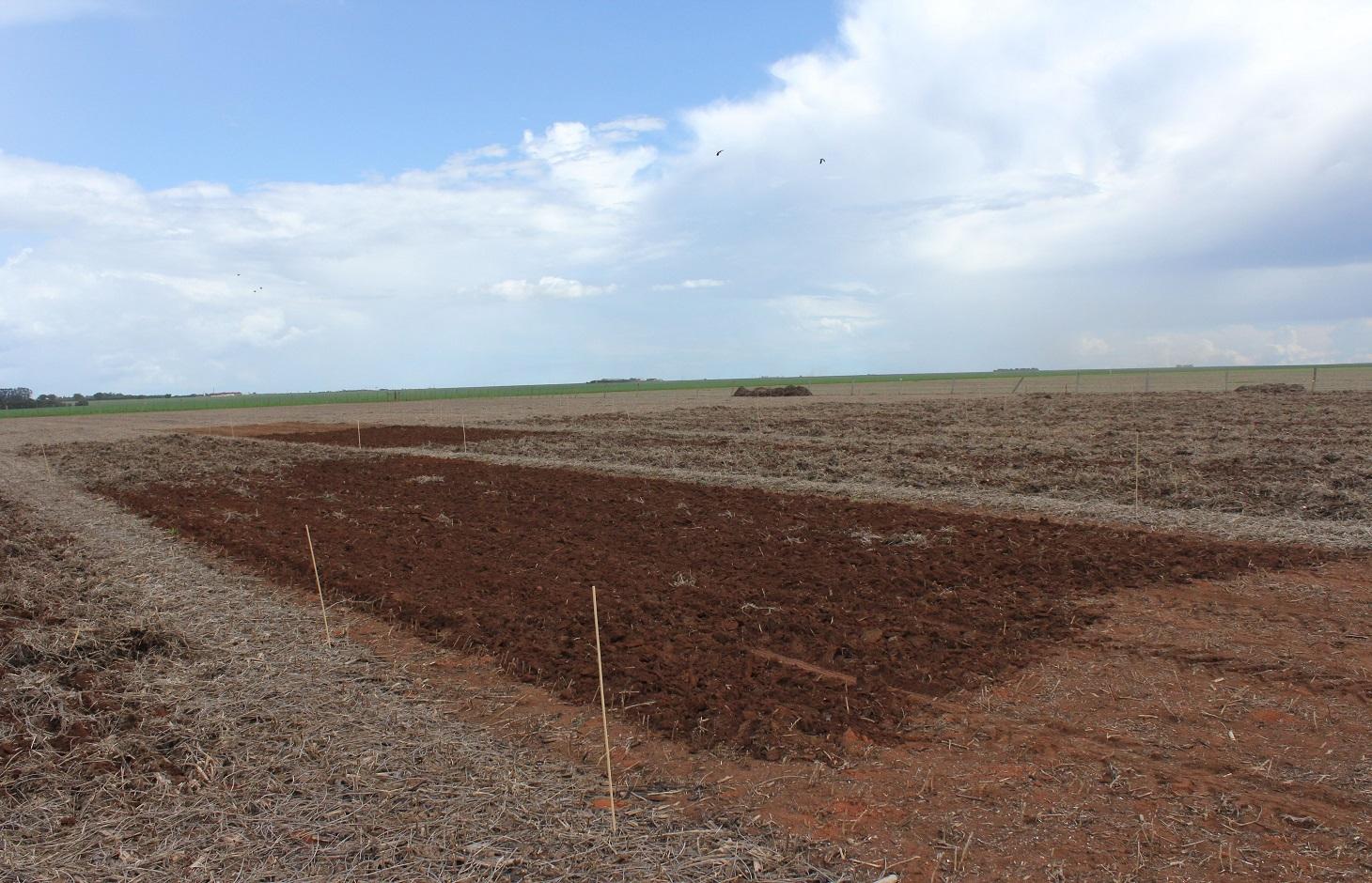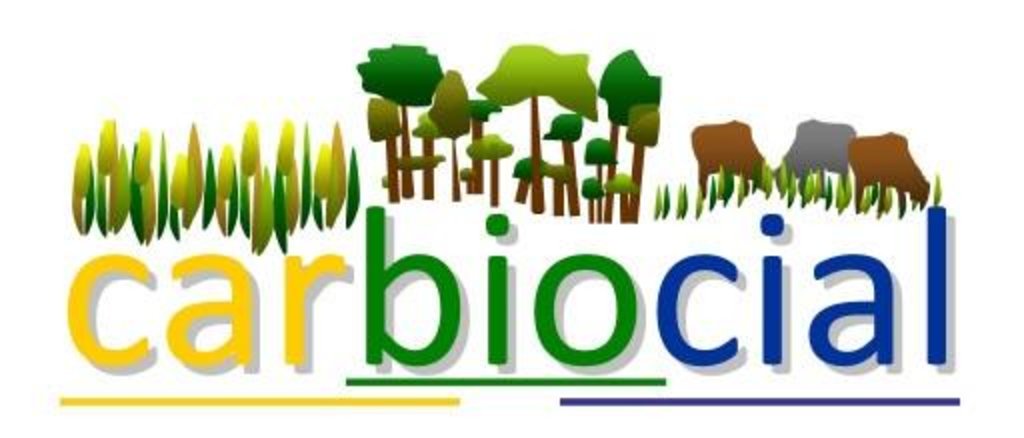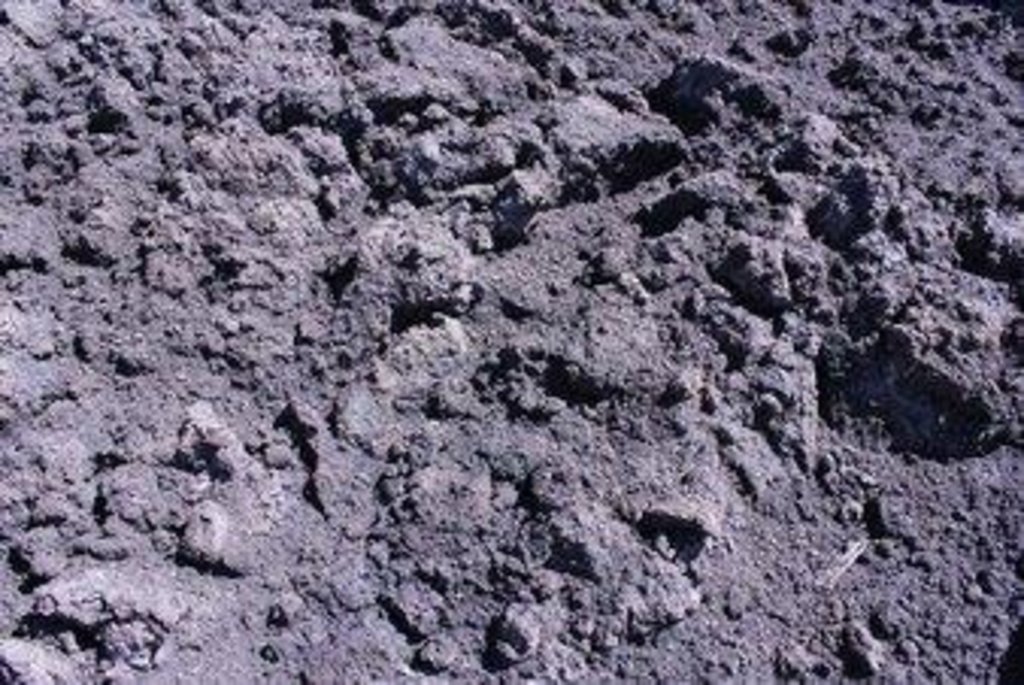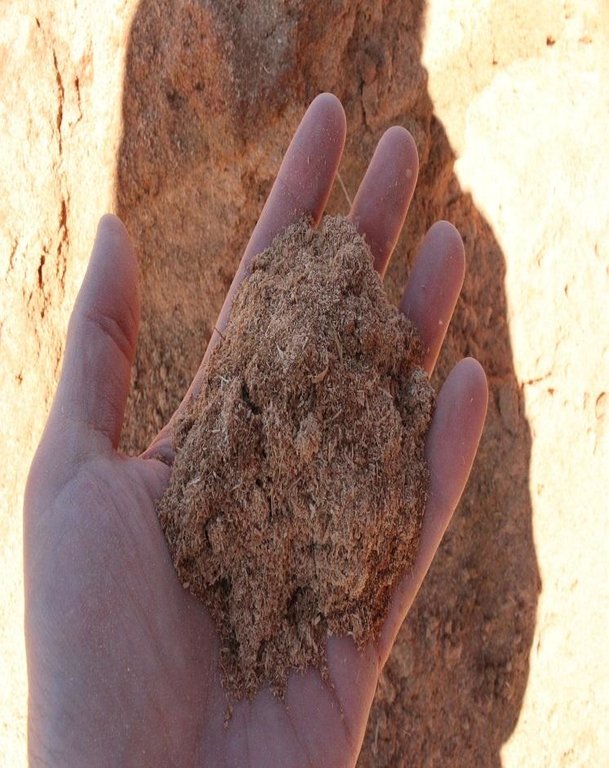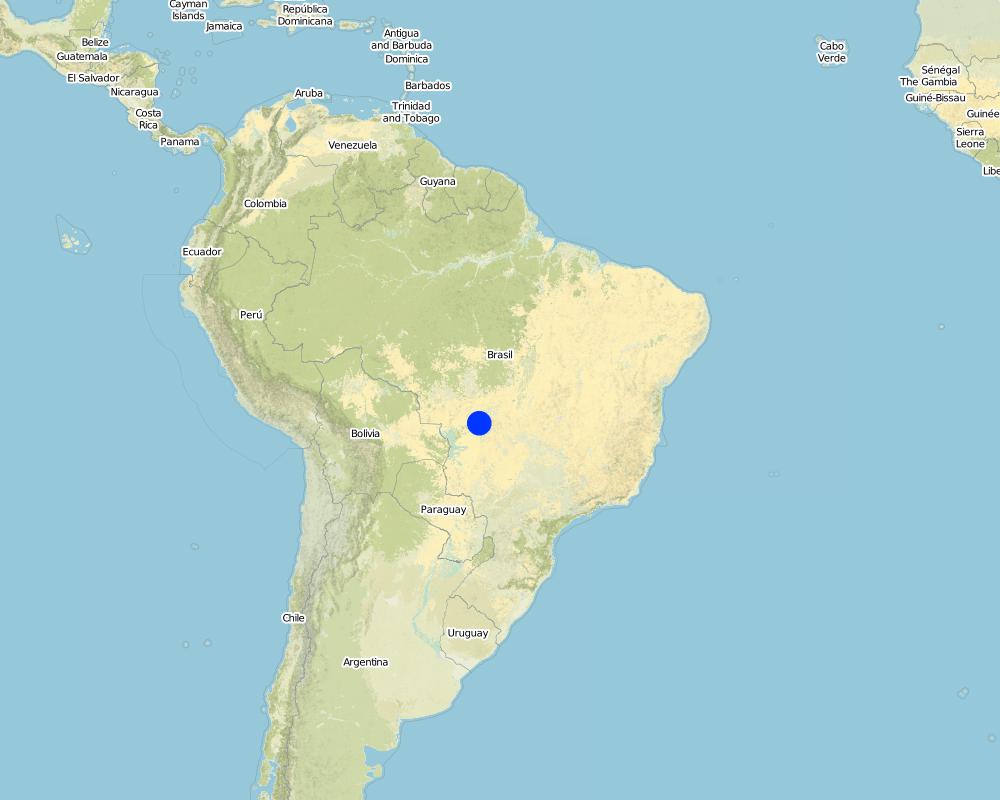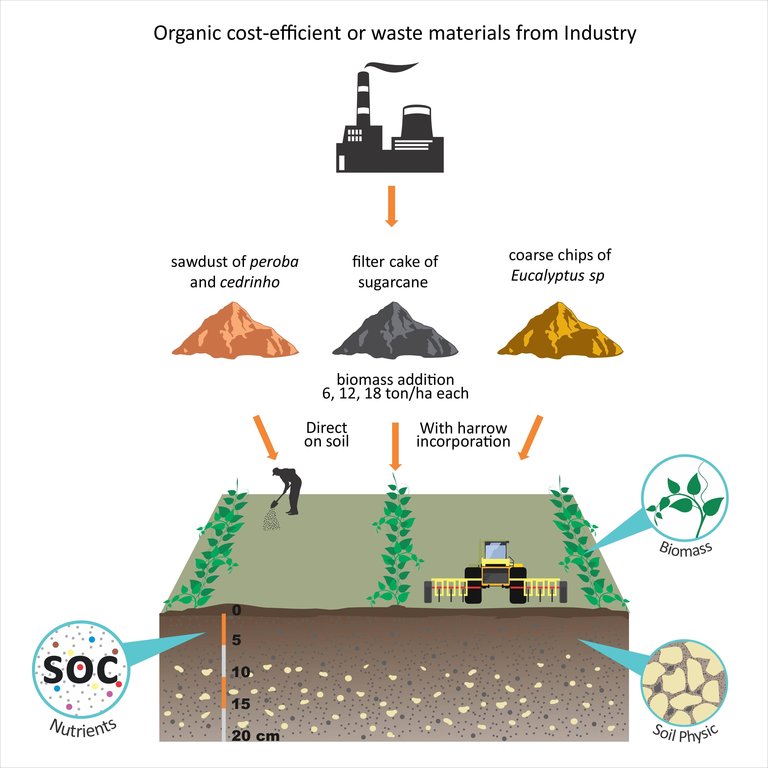Carbon-enrichment of tropical agricultural soil with organic matter [ប្រទេសប្រេស៊ីល]
- ការបង្កើត៖
- បច្ចុប្បន្នភាព
- អ្នកចងក្រង៖ Luisa F. Vega
- អ្នកកែសម្រួល៖ –
- អ្នកត្រួតពិនិត្យច្រើនទៀត៖ Alexandra Gavilano, Deborah Niggli, David Streiff
Enriquecimento de carbono em solo de lavoura com matéria orgânica (Brazil)
technologies_1250 - ប្រទេសប្រេស៊ីល
- សង្ខេបជា PDF
- សេចក្តីសង្ខេបពេញលេញជាទម្រង់ PDF សម្រាប់បោះពុម្ព
- សេចក្តីសង្ខេបពេញលេញទម្រង់អ៊ីនធឺនេត
- សេចក្តីសង្ខេបពេញលេញ (មិនមានទម្រង់ជាក់លាក់)
- Carbon-enrichment of tropical agricultural soil with organic matter: 5 ខែ មករា ឆ្នាំ 2017 (inactive)
- Carbon-enrichment of tropical agricultural soil with organic matter: 7 ខែ មិនា ឆ្នាំ 2017 (inactive)
- Carbon-enrichment of tropical agricultural soil with organic matter: 29 ខែ មេសា ឆ្នាំ 2017 (inactive)
- Carbon-enrichment of tropical agricultural soil with organic matter: 7 ខែ មិនា ឆ្នាំ 2019 (public)
ពិនិត្យមើលគ្រប់ផ្នែក
ពង្រីកមើលទាំងអស់ បង្រួមទាំងអស់1. ព័ត៌មានទូទៅ
1.2 ព័ត៌មានលម្អិតពីបុគ្គលសំខាន់ៗ និងស្ថាប័នដែលចូលរួមក្នុងការវាយតម្លៃ និងចងក្រងឯកសារនៃបច្ចេកទេស
អ្នកជំនាញឯកទេស SLM:
Irmler Prof. Dr. Ulrich
Institute for Ecosystem Research
ប្រទេសអាល្លឺម៉ង់
អ្នកជំនាញឯកទេស SLM:
Wantzen Prof. Dr. Karl M.
CNRS UMR CITERES
ប្រទេសបារាំង
ឈ្មោះគម្រោងដែលបានចងក្រងឯកសារ/ វាយតម្លៃលើបច្ចេកទេស (បើទាក់ទង)
Book project: Making sense of research for sustainable land management (GLUES)ឈ្មោះគម្រោងដែលបានចងក្រងឯកសារ/ វាយតម្លៃលើបច្ចេកទេស (បើទាក់ទង)
Carbon optimized land management strategies for southern Amazonia (CARBIOCIAL / GLUES)ឈ្មោះអង្គភាពមួយ (ច្រើន) ដែលបានចងក្រងឯកសារ/ វាយតម្លៃបច្ចេកទេស (បើទាក់ទង)
University of Kiel (University of Kiel) - ប្រទេសអាល្លឺម៉ង់ឈ្មោះអង្គភាពមួយ (ច្រើន) ដែលបានចងក្រងឯកសារ/ វាយតម្លៃបច្ចេកទេស (បើទាក់ទង)
Universidade Federal de Mato Grosso (Universidade Federal de Mato Grosso) - ប្រទេសប្រេស៊ីលឈ្មោះអង្គភាពមួយ (ច្រើន) ដែលបានចងក្រងឯកសារ/ វាយតម្លៃបច្ចេកទេស (បើទាក់ទង)
Université Francois-Rabelais de Tours (Université Francois-Rabelais de Tours) - ប្រទេសបារាំង1.3 លក្ខខណ្ឌទាក់ទងទៅនឹងការប្រើប្រាស់ទិន្នន័យដែលបានចងក្រងតាមរយៈ វ៉ូខេត
អ្នកចងក្រង និង(បុគ្គលសំខាន់ៗ)យល់ព្រមទទួលយកនូវលក្ខខណ្ឌនានាទាក់ទងទៅនឹងការប្រើប្រាស់ទិន្នន័យដែលបានចងក្រងតាមរយៈវ៉ូខេត:
បាទ/ចា៎
1.4 សេចក្តីប្រកាសស្តីពីចីរភាពនៃការពណ៌នាពីបច្ចេកទេស
តើបច្ចេកទេសដែលបានពណ៌នានេះមានបញ្ហាដែលផ្តោតលើការធ្លាក់ចុះគុណភាពដី, បើដូច្នេះវាមិនអាចត្រូវបានប្រកាសថាជាបច្ចេកទេសនៃការគ្រប់គ្រងប្រកបដោយចីរភាពទេ?
ទេ
1.5 ការយោងទៅលើកម្រងបញ្ជីសំណួរ (មួយ ឬច្រើន) នៃវិធីសាស្ត្រផ្សព្វផ្សាយ SLM (ដែលបានចងក្រងដោយទស្សនៈពិភពលោកស្តីពីវិធីសាស្ត្រ និងបច្ចេកទេសងអភិរក្ស WOCAT)
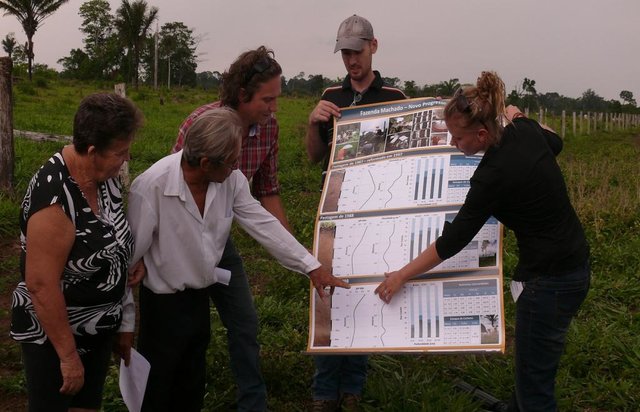
From storylines to scenarios: raising awareness and decision … [ប្រទេសប្រេស៊ីល]
Investigating viable carbon-optimized land management strategies, which maintain or improve ecosystem function, under changing climate conditions in the Southern Amazon - using regional scenarios generated from storylines.
- អ្នកចងក្រង៖ Jan Goepel
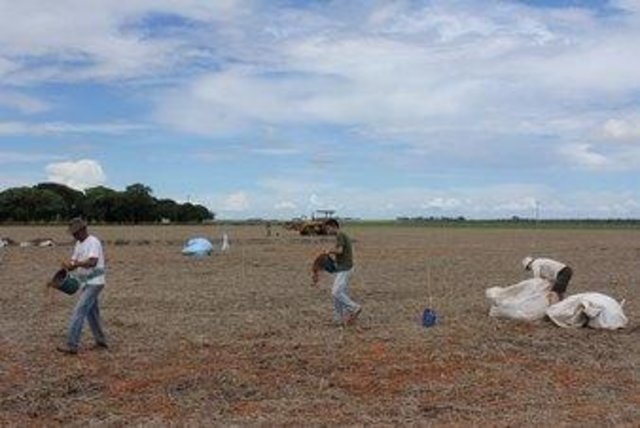
Enrichment of Tropical Agricultural Soil with Organic Matter [ប្រទេសប្រេស៊ីល]
Enrichment of tropical agicultural soils with local available organic matter in the cerrado agroscape, Brazil.
- អ្នកចងក្រង៖ Luisa F. Vega
2. ការពណ៌នាពីបច្ចេកទេស SLM
2.1 ការពណ៌នាដោយសង្ខេបពីបច្ចេកទេស
និយមន័យបច្ចេកទេស:
Carbon-enrichment of tropical agricultural soils with locally available organic matter in the Cerrado agricultural landscape, Brazil.
2.2 ការពណ៌នាលម្អិតពីបច្ចេកទេស
ការពណ៌នា:
In the Carbiocial Project viable land management strategies were explored to optimize the level of carbon in soil and water, helping to maintain and/or improve ecosystem functions, under changing climatic conditions in the Southern Amazon and the Brazilian Cerrado. In the framework of this project, on-farm experiments were performed to enrich tropical agricultural soils in the medium term, with different types of organic matter (OM). In the experiment the effect of different types of OM amendments on soil carbon and macro-nutrients (N, P, and K), soil physical properties (waterholding capacity) and crop yield (soy biomass and grain production) were assessed. The amendments applied are locally available, and are either free (being waste materials) or considered cost-efficient.
The objective of this on-going experiment is to compare the impact of (i) the quality and quantity of OM applied, (ii) and the application methods (directly on the soil surface or incorporation by harrow) on soil chemical and physical properties. It is hypothesised that the addition of OM can enhance crop yields and, potentially, soil biodiversity. The effects of the different OM types, amounts and application methods were evaluated after one, two and three years. From the results, the aim is to provide recommendations for the development of soil OM-enrichment schemes and carbon-friendly landscape management programs for farmers, using local resources.
The experiment was established on an area of about one hectare on a ferrasol (red latosol) at the Rio Engano Farm, in the municipality of Campo Verde, Mato Grosso State. The farm has a total area of ca. 1500 ha, 830 ha of which are cultivated with soybean and maize rotation, under a zero-tillage system, which is typical of many farms in this region. It is located in the Brazilian Cerrado (savanna) biome at about 685 m a.s.l. This biome covers 2 million km2, which is 23% of the country area. It has a semi-humid climate with a pronounced dry season. The precipitation during the rainy season (September-April) varies between 800 and 2000 mm/year.
At the beginning of the experiment (February 2012), three different types of OM amendments were applied. They comprised (a) sugarcane filter cake (Saccharum officinarum from ethanol/sugar-production, (b) sawdust of peroba and cedrinho (Peroba jaune and Erisma uncinatum, respectively) and (c) coarse chips of Eucalyptus sp. Quantities applied were 0 (control), 6, 12 and 18 tonnes of each per hectare; using two methods: directly on the soil surface, and incorporated by harrow. There were three repetitions per treatment. The area was not fenced to allow the farmers to continue with their field routines on all plots. In February 2013, 2014 and 2015 soil samples were taken to analyze their chemical and physical properties. Soybean samples were also taken in February 2014 and 2015 to estimate biomass and grain production. From the initial results some conclusions can be drawn: 1) Organic amendment addition to ferrasols can significantly increase soil organic carbon, even in amounts as low as 6 t/ha. 2) Amendments should be reapplied every 2 years. 3) The amendment type and application method does not have a significant effect on increasing soil organic carbon. 4) The addition of OM amendments is a win-win situation as a solution for organic matter waste recycling, and simultaneously to improve soil quality.
The area was not fenced to allow the farmer to continue with their arable field routines on all treatment plots. In February 2013, 2014 and 2015 soil samples were taken to analyze their chemical and physical properties. Soy bean samples were also taken in February 2014 and 2015 to estimate biomass and grain production.
From our first results we can draw some conclusions:
1) Organic amendment addition to Ferrasol can increase significantly soil organic carbon (SOC) percentage, even in small amounts such as 6 ton/ha.
2) Amendment reapplication should be done in 2 years intervals.
3) The amendment type and disposition did not have a significant effect on increasing SOC.
4) The addition of OM amendments is a win-win situation as a solution for organic matter waste recycling and to improve soil quality.
2.3 រូបភាពនៃបច្ចេកទេស
2.5 ប្រទេស/តំបន់/ទីតាំងកន្លែង ដែលបច្ចេកទេសត្រូវបានអនុវត្ត និងបានគ្រប់ដណ្តប់ដោយការវាយតម្លៃនេះ
ប្រទេស:
ប្រទេសប្រេស៊ីល
តំបន់/រដ្ឋ/ខេត្ត:
Mato Grosso
បញ្ជាក់បន្ថែមពីលក្ខណៈនៃទីតាំង:
Campo Verde
បញ្ជាក់ពីការសាយភាយនៃបច្ចេកទេស:
- ត្រូវបានផ្សព្វផ្សាយត្រឹមតំបន់មួយ
ប្រសិនបើបច្ចេកទេសត្រូវបានសាយភាយពាសពេញតំបន់ណាមួយ បញ្ជាក់ទំហំផ្ទៃដីអនុវត្តន៍ (គិតជា គ.ម2):
0,011544
មតិយោបល់:
Total area covered by the SLM Technology is 0.011544 km2.
In the São Valentim Farm, located in the Brazilian Cerrado (savanna) biome. The experimental soil enrichment was established in February 2012, on a Ferrasol. The area was under a soybean-corn crop rotation
Map
×2.6 កាលបរិច្ឆេទនៃការអនុវត្ត
ប្រសិនបើមិនច្បាស់ឆ្នាំ សូមបញ្ជាក់កាលបរិច្ឆេទដែលប្រហាក់ប្រហែល:
- តិចជាង 10ឆ្នាំមុន (ថ្មី)
2.7 ការណែនាំពីបច្ចេកទេស
សូមបញ្ជាក់តើបច្ចេកទេសត្រូវបានណែនាំឱ្យអនុវត្តដោយរបៀបណា:
- ពេលកំពុងពិសោធន៍
- តាមរយៈគម្រោង / អន្តរាគមន៍ពីខាងក្រៅ
មតិយោបល់ (ប្រភេទនៃគម្រោង ។ល។):
The enrichment of the soil by OM application is a traditional practice. Some of the added OM types in this experimet are already used in the Cerrado without any technical specification. This project aim to identify of one or more types, amounts and application methods of OM, which improve significantly soil quality and carbon stock. The OM effects are evaluated after 2 and 3 years of its addition, which was initially done in February 2012.
3. ចំណាត់ថ្នាក់នៃបច្ចេកទេស SLM
3.1 គោលបំណងចម្បង (១ ឬច្រើន) នៃបច្ចេកទេសនេះ
- ធ្វើឱ្យប្រសើរឡើងនូវផលិតកម្ម
- អភិរក្សប្រព័ន្ធអេកូឡូស៊ី
3.2 ប្រភេទដីប្រើប្រាស់មួយប្រភេទ (ច្រើនប្រភេទ) ដែលបានអនុវត្តបច្ចេកទេស
ដីប្រើប្រាស់ចម្រុះនៅលើដីតែមួយ:
បាទ/ចា៎
បញ្ជាក់ពីប្រភេទដីច្រើនប្រភេទ (ដីដាំដំណាំ/ដីចិញ្ចឹមសត្វ/ដីព្រៃឈើ):
- Agro-pastoralism ( រួមបញ្ចូលទាំងដំណាំ និងចិញ្ចឹមសត្វ)

ដីដាំដំណាំ
- ដំណាំប្រចាំឆ្នាំ
ចំនួនសារដែលដាំដំណាំក្នុងមួយឆ្នាំ:
- 2
សូមបញ្ជាក់:
Longest growing period in days: 150, Longest growing period from month to month: November to March; Second longest growing period in days: 120, Second longest growing period from month to month: April to July

ដីសម្រាប់ចិញ្ចឹមសត្វ
វាលស្មៅធំៗ:
- បែងចែកវាលស្មៅជាប្លុក
ដីវាលស្មៅតូចៗ/ ផលិតកម្មចំណី:
- កាត់ និងជញ្ជូន/ គ្មានវាលស្មៅសម្រាប់ចិញ្ចឹមសត្វ
មតិយោបល់:
Major land use problems (compiler’s opinion): Croplands demonstrate a reduction in soil organic matter, after their conversion from indigenous vegetation into agricultural fields. It is especially critical in the ferrasol soils of the Brazilian Cerrado, as its organic matter content is relatively low, and tropical temperatures and humidity accelerate microbial activity (Price and Sowers 2004)
Major land use problems (land users’ perception): There are also problems regarding soil compaction and rainfall regime change
Grazingland comments: There is some grazing by tapir, capibara, wild pig, ema, papagay
Type of grazing system comments: There is some grazing by tapir, capibara, wild pig, ema, papagay
Livestock density: > 100 LU /km2
3.4 ការផ្គត់ផ្គង់ទឹក
ការផ្គត់ផ្គង់ទឹកនៅកន្លែងអនុវត្តបច្ចេកទេស:
- ទឹកភ្លៀង
3.5 ក្រុម SLM ដែលបច្ចេកទេសស្ថិតនៅក្នុង
- ការគ្រប់គ្រងជីជាតិដីតាមបែបចម្រុះ
3.6 វិធានការ SLM ដែលបញ្ចូលនូវបច្ចេកទេស

វិធានការក្សេត្រសាស្ត្រ
- A2: សារធាតុសរីរាង្គ/ជីជាតិដី
- A3: ការរក្សាស្រទាប់ដីខាងលើ
- A4: ការរក្សាស្រទាប់ដីខាងក្នុង
មតិយោបល់:
Type of agronomic measures: manure / compost / residues, zero tillage / no-till, non-inversion tillage
3.7 កំណត់ប្រភេទនៃការធ្លាក់ចុះគុណភាពដីសំខាន់ៗដែលបច្ចេកទេសនេះបានដោះស្រាយ

ការហូរច្រោះដីដោយសារទឹក
- Wt: ការបាត់ដីស្រទាប់លើដោយការហូរច្រោះ

ការធ្លាក់ចុះសារធាតុគីមីក្នុងដី
- Cn: ការថយចុះជីជាតិ និងកាត់បន្ថយបរិមាណសារធាតុសរីរាង្គ (មិនកើតឡើងដោយការហូរច្រោះទេ)

ការបាត់បង់រូបសាស្ត្រនៃដី
- Pc: ការហាប់ណែន

ការធ្លាក់ចុះជីវសាស្ត្រនៃដី
- Bs: សមាសភាពដែលមានគុណភាពនិងប្រភេទសត្វ/ការថយចុះនូវជីវចម្រុះ
មតិយោបល់:
Main causes of degradation: soil management (Extensive areas of monoculture), crop management (annual, perennial, tree/shrub) (Intensive soil use), deforestation / removal of natural vegetation (incl. forest fires) (In the region, the native vegetation of Cerrado was deforested during the early 80´s for agricultural purposes.), population pressure (Most of the agricultural production from The Brazilian Cerrado meet the food demand from Europe and China)
Secondary causes of degradation: Heavy / extreme rainfall (intensity/amounts) (There is an increase of extreme rainfall events which take place during the rainy season), labour availability (Reduction of availability of skilled labor for instance, to carry out integral monitoring of plagues), education, access to knowledge and support services (There a positive relationship between education level of farmers and the adoption of new technologies for sustainable land management), governance / institutional (Part of the colonization and conversion of the Brazilian Cerrado into agricultural systems was encouraged by Research (Embrapa) and Financing Government Programs)
3.8 ការពារ កាត់បន្ថយ ឬស្តារឡើងវិញនៃការធ្លាក់ចុះគុណភាពដី
បញ្ជាក់ពីគោលដៅរបស់បច្ចេកទេស ដែលផ្តោតទៅការធ្លាក់ចុះគុណភាពដី:
- ការកាត់បន្ថយការធ្លាក់ចុះគុណភាពដី
4. បច្ចេកទេសជាក់លាក់ សកម្មភាពអនុវត្ត ធាតុចូល និងថ្លៃដើម
4.1 គំនូសបច្ចេកទេសនៃបច្ចេកទេសនេះ
លក្ខណៈពិសេសនៃបច្ចេកទេស (ទាក់ទងនឺងគំនូរបច្ចេកទេស):
Enrichment of Tropical agricultural soil (Ferrasol) with organic matter amendments. Experimental design: amendment types, amounts and disposition methods (direct on the soil or with harrow incorporation). Studied variables: soil carbon and nutrients, soil physical properties (water holding capacity) and crop yield (soy biomass and grain production).
Location: Rio Engano Ranch. Campo Verde / Mato Grosso / Brazil
Date: 6.11.2015
Technical knowledge required for field staff / advisors: low
Technical knowledge required for land users: low
Main technical functions: increase in organic matter, increase / maintain water stored in soil
Secondary technical functions: control of raindrop splash, control of dispersed runoff: impede / retard, improvement of topsoil structure (compaction), stabilisation of soil (eg by tree roots against land slides), increase in nutrient availability (supply, recycling,…), increase of infiltration, increase of groundwater level / recharge of groundwater, water harvesting / increase water supply
Manure / compost / residues
Material/ species: (a) Filter cake of sugarcane residues (Saccharum officinarum from alcohol/sugar-production, (b) saw
Quantity/ density: 6, 12, 18
Zero tillage / no-till
Remarks: A part of the organic matter was added directly on the soil surface
Non-inversion tillage
Remarks: Another part of the organic matter was incorporate into the soil by using harrow
ឈ្មោះអ្នកនិពន្ធ:
Diego Orduz, orduzrobles@gmail.com
4.2 ព័ត៌មានទូទៅដែលពាក់ព័ន្ធនឹងការគណនាធាតុចូល និងថ្លៃដើម
ផ្សេងៗ/ រូបិយប័ណ្ណជាតិ (បញ្ជាក់):
BRL
បើពាក់ព័ន្ធសូមកំណត់អត្រាប្តូរប្រាក់ពីដុល្លាទៅរូបិយប័ណ្ណតំបន់ (ឧ. 1 ដុល្លារ = 79.9 រៀលនៃរូបិយប័ណ្ណប្រេស៊ីល) ៖ 1 ដុល្លារ =:
4,0
កំណត់ថ្លៃឈ្នួលជាមធ្យមនៃការជួលកម្លាំងពលកម្មក្នុងមួយថ្ងៃ:
25.00
4.4 ថ្លៃដើម និងធាតុចូលដែលត្រូវការសម្រាប់ការបង្កើតបច្ចេកទេស
មតិយោបល់:
Duration of establishment phase: 0 month(s)
4.5 សកម្មភាពថែទាំ
| សកម្មភាព | ពេលវេលា/ ភាពញឹកញាប់ | |
|---|---|---|
| 1. | 1.Transport of amendments by trucks (0.2 tonne/US$) | |
| 2. | 2.Spreading / incorporation of organic matter by tractor (US$ 3/ha for petrol and US$ 5/ha for tractor driver). |
4.6 កំណត់ថ្លៃដើមសម្រាប់ការថែទាំ/ សកម្មភាពរបស់បច្ចេកទេស (ក្នុងរយៈពេលមួយឆ្នាំ)
| បញ្ជាក់ពីធាតុចូល | ឯកតា | បរិមាណ | ថ្លៃដើមក្នុងមួយឯកតា | ថ្លៃធាតុចូលសរុប | % នៃថ្លៃដើមដែលចំណាយដោយអ្នកប្រើប្រាស់ដី | |
|---|---|---|---|---|---|---|
| កម្លាំងពលកម្ម | labour | ha | 1,0 | 5,0 | 5,0 | 100,0 |
| សម្ភារៈ | machine use | ha | 1,0 | 15,0 | 15,0 | 100,0 |
| សម្ភារៈ | truck transport | ha | 1,0 | 150,0 | 150,0 | 100,0 |
| ថ្លៃដើមសរុបសម្រាប់ការថែទាំដំណាំតាមបច្ចេកទេស | 170,0 | |||||
| ថ្លៃដើមសរុបសម្រាប់ការថែទាំដំណាំតាមបច្ចេកទេសគិតជាដុល្លារ | 42,5 | |||||
4.7 កត្តាសំខាន់បំផុតដែលមានឥទ្ធិពលដល់ការចំណាយ
ពណ៌នាពីកត្តាប៉ះពាល់ចម្បងៗទៅលើថ្លៃដើម:
Amendment truck transport (0,2 ton/US$), amendment application by tractor(15 US$*ha/dia)
and tractor driver (5 US$*ha) costs.
The used organic matter amendments are cost-free. It is suggested to use cost-free materials if possible or cost–efficient materials to reduce implementation and maintenance costs. Transport of amendments is paid by tonne, independently of the type. The OM application methods (direct on the soil by hand or with harrow incorporation) did not show significant differences. For this reason only the costs for the tractor were calculated, because it is a more economic option.
5. លក្ខណៈបរិស្ថានធម្មជាតិ និងមនុស្ស
5.1 អាកាសធាតុ
បរិមាណទឹកភ្លៀងប្រចាំឆ្នាំ
- < 250 មម
- 251-500 មម
- 501-750 មម
- 751-1,000 មម
- 1,001-1,500 មម
- 1,501-2,000 មម
- 2,001-3,000 មម
- 3,001-4,000 មម
- > 4,000 មម
លក្ខណៈពិសេស/ មតិយោបល់លើរដូវភ្លៀង:
The area presents strong seasonality: dry season (May-Sep) and rainy season (Oct-Apr)
តំបន់កសិអាកាសធាតុ
- មានភ្លៀងមធ្យម
Thermal climate class: tropics
5.2 សណ្ឋានដី
ជម្រាលជាមធ្យម:
- រាបស្មើ (0-2%)
- ជម្រាលតិចតួច (3-5%)
- មធ្យម (6-10%)
- ជម្រាលខ្ពស់បន្តិច (11-15%)
- ទីទួល (16-30%)
- ទីទួលចោត (31-60%)
- ទីទួលចោតខ្លាំង (>60%)
ទម្រង់ដី:
- ខ្ពង់រាប
- កំពូលភ្នំ
- ជម្រាលភ្នំ
- ជម្រាលទួល
- ជម្រាលជើងភ្នំ
- បាតជ្រលងភ្នំ
តំបន់តាមរយៈកម្ពស់ :
- 0-100 ម
- 101-500 ម
- 501-1,000 ម
- 1,001-1,500 ម
- 1,501-2,000 ម
- 2,001-2,500 ម
- 2,501-3,000 ម
- 3,001-4,000 ម
- > 4,000 ម
5.3 ដី
ជម្រៅដីជាមធ្យម:
- រាក់ខ្លាំង (0-20 សម)
- រាក់ (21-50 សម)
- មធ្យម (51-80 សម)
- ជ្រៅ (81-120 សម)
- ជ្រៅខ្លាំង (> 120 សម)
វាយនភាពដី (ស្រទាប់លើ):
- ម៉ត់/ ធ្ងន់ (ឥដ្ឋ)
សារធាតុសរីរាង្គនៅស្រទាប់ដីខាងលើ:
- ខ្ពស់ (>3%)
5.4 ទឹកដែលអាចទាញមកប្រើប្រាស់បាន និងគុណភាពទឹក
នីវ៉ូទឹកក្រោមដី:
5-50 ម
ទឹកលើដីដែលអាចទាញយកប្រើប្រាស់បាន:
ល្អ
គុណភាពទឹក (មិនបានធ្វើប្រត្តិកម្ម):
ទឹកសម្រាប់តែការធ្វើកសិកម្ម (ស្រោចស្រព)
5.5 ជីវៈចម្រុះ
ភាពសម្បូរបែបនៃប្រភេទ:
- ទាប
5.6 លក្ខណៈនៃអ្នកប្រើប្រាស់ដីដែលអនុវត្តបច្ចេកទេស
ទីផ្សារនៃប្រព័ន្ធផលិតកម្ម:
- ពាណិជ្ជកម្ម/ ទីផ្សារ
ចំណូលក្រៅកសិកម្ម:
- តិចជាង 10% នៃចំណូល
កម្រិតជីវភាព:
- មធ្យម
- មាន
ឯកជន ឬក្រុម:
- ធ្វើខ្លួនឯង/ គ្រួសារ
កម្រិតប្រើប្រាស់គ្រឿងយន្ត:
- គ្រឿងយន្ត/ ម៉ាស៊ីន
យេនឌ័រ:
- បុរស
សូមបញ្ជាក់ពីលក្ខណៈពាក់ព័ន្ធផ្សេងទៀតអំពីអ្នកប្រើប្រាស់ដី:
Land users applying the Technology are mainly common / average land users
Difference in the involvement of women and men: In the Cerrado most of the extensive crops (soy bean, corn and cotton) are managed by men
Population density: < 10 persons/km2
Annual population growth: > 4%; 7%
3% of the land users are very rich.
46% of the land users are rich.
51% of the land users are average wealthy.
Off-farm income specification: The off-farm income in the Cerrado is in most cases not relevant for farmers, both applying or not conservation meaures. Their income depent principally on agricultural activities such as soy bean, corn and cotton crops among others.
5.7 ទំហំផ្ទៃដីជាមធ្យមនៃដីប្រើប្រាស់ដោយអ្នកប្រើប្រាស់ដី ក្នុងការអនុវត្តបច្ចេកទេស
- < 0.5 ហិកតា
- 0.5-1 ហិកតា
- 1-2 ហិកតា
- 2-5 ហិកតា
- 5-15 ហិកតា
- 15-50 ហិកតា
- 50-100 ហិកតា
- 100-500 ហិកតា
- 500-1,000 ហិកតា
- 1,000-10,000 ហិកតា
- > 10,000 ហិកតា
តើផ្ទៃដីនេះចាត់ទុកជាទំហំកម្រិតណាដែរ ខ្នាតតូច មធ្យម ឬខ្នាតធំ (ធៀបនឹងបរិបទតំបន់)?
- ខ្នាតតូច
5.8 ភាពជាម្ចាស់ដី កម្មសិទ្ធប្រើប្រាស់ដី និងកម្មសិទ្ធប្រើប្រាស់ទឹក
ភាពជាម្ចាស់ដី:
- ឯកជន មានកម្មសិទ្ធ
កម្មសិទ្ធិប្រើប្រាស់ដី:
- ឯកជន
កម្មសិទ្ធប្រើប្រាស់ទឹក:
- កិច្ចសន្យាជួល
មតិយោបល់:
The water used is regulated by the Environmental Secretary of the State (SEMA). Thus, water users have to obtain an Environmental License, where the volumen of water consumption is declared. The license is free of charge.
5.9 ការប្រើប្រាស់សេវាកម្ម និងហេដ្ឋារចនាសម្ព័ន្ធ
សុខភាព:
- មិនល្អ
- មធ្យម
- ល្អ
ការអប់រំ:
- មិនល្អ
- មធ្យម
- ល្អ
ជំនួយបច្ចេកទេស:
- មិនល្អ
- មធ្យម
- ល្អ
ការងារ (ឧ. ការងារក្រៅកសិដ្ឋាន):
- មិនល្អ
- មធ្យម
- ល្អ
ទីផ្សារ:
- មិនល្អ
- មធ្យម
- ល្អ
ថាមពល:
- មិនល្អ
- មធ្យម
- ល្អ
ផ្លូវ និងការដឹកជញ្ជូន:
- មិនល្អ
- មធ្យម
- ល្អ
ទឹកផឹក និងអនាម័យ:
- មិនល្អ
- មធ្យម
- ល្អ
សេវាកម្មហិរញ្ញវត្ថុ:
- មិនល្អ
- មធ្យម
- ល្អ
6. ផលប៉ះពាល់ និងការសន្និដ្ឋាន
6.1 ផលប៉ះពាល់ក្នុងបរិវេណអនុវត្តបច្ចេកទេសដែលកើតមាន
ផលប៉ះពាល់លើសេដ្ឋកិច្ចសង្គម
ផលិតផល
ផលិតកម្មដំណាំ
ហានិភ័យនៃភាពបរាជ័យរបស់ផលិតកម្ម
ការគ្រប់គ្រងដី
មតិយោបល់/ ការបញ្ជាក់:
There is not specific machinery for organic matter application in large scale
ទឹកដែលអាចទាញមកប្រើប្រាស់បាន និងគុណភាពទឹក
តម្រូវការទឹកសម្រាប់ស្រោចស្រព
ចំណូល និងថ្លៃដើម
ការចំណាយលើធាតុចូលកសិកម្ម
ចំណូលក្នុងកសិដ្ឋាន
មតិយោបល់/ ការបញ្ជាក់:
In case the technology reduces the crop demand for chemical fertilization, nonetheless this effect has not been yet evaluated
ផលប៉ះពាល់ទៅលើសេដ្ឋកិច្ចសង្គមផ្សេងៗ
It provides a better environmental and technical use for agroindustrial residues
costs of transport and application of OM amendments
ផលប៉ះពាល់ទៅលើវប្បធម៌សង្គម
ការកាត់បន្ថយជម្លោះ
ផលប៉ះពាល់ទៅលើអេកូឡូស៊ី
ដី
សំណើមដី
វដ្តនៃសារធាតុចិញ្ចឹម/ការទទួលបាន
សារធាតុសរីរាង្គដី/ការបូនក្រោមដី
ជីវចម្រុះ៖ ដំណាំ, សត្វ
ជីវម៉ាស/ កាបូនលើដី
ផលប៉ះពាល់ទៅលើអេកូឡូស៊ីផ្សេងៗ
increased soil micro-organisms and fauna
6.3 ភាពប្រឈម និងភាពរួសនៃបច្ចេកទេសទៅនឹងការប្រែប្រួលអាកាសធាតុ និងគ្រោះអាកាសធាតុ/ គ្រោះមហន្តរាយ (ដែលដឹងដោយអ្នកប្រើប្រាស់ដី)
ការប្រែប្រួលអាកាសធាតុ
ការប្រែប្រួលអាកាសធាតុ
| រដូវកាល | កើនឡើង ឬថយចុះ | លក្ខណៈឆ្លើយតបនៃបច្ចេកទេសទៅនឹងការប្រែប្រួលអាកាសធាតុ | |
|---|---|---|---|
| សីតុណ្ហភាពប្រចាំឆ្នាំ | កើនឡើង | មិនល្អ |
គ្រោះអាកាសធាតុ (មហន្តរាយ)
គ្រោះមហន្តរាយធម្មជាតិ
| លក្ខណៈឆ្លើយតបនៃបច្ចេកទេសទៅនឹងការប្រែប្រួលអាកាសធាតុ | |
|---|---|
| ព្យុះភ្លៀងតាមតំបន់ | ល្អ |
| ព្យុះកំបុតត្បូងតាមតំបន់ | ល្អ |
គ្រោះមហន្តរាយអាកាសធាតុ
| លក្ខណៈឆ្លើយតបនៃបច្ចេកទេសទៅនឹងការប្រែប្រួលអាកាសធាតុ | |
|---|---|
| រាំងស្ងួត | មិនល្អ |
គ្រោះមហន្តរាយទឹក
| លក្ខណៈឆ្លើយតបនៃបច្ចេកទេសទៅនឹងការប្រែប្រួលអាកាសធាតុ | |
|---|---|
| ទឹកជំនន់ទូទៅ (ទន្លេ) | មិនល្អ |
ផលវិបាកដែលទាក់ទងនឹងបរិយាកាសផ្សេងៗទៀត
ផលវិបាកដែលទាក់ទងនឹងបរិយាកាសផ្សេងៗទៀត
| លក្ខណៈឆ្លើយតបនៃបច្ចេកទេសទៅនឹងការប្រែប្រួលអាកាសធាតុ | |
|---|---|
| កាត់បន្ថយពេលដាំដុះ | មិនល្អ |
6.4 ការវិភាគថ្លៃដើម និងអត្ថប្រយោជន៍
តើផលចំណេញ និងថ្លៃដើមត្រូវបានប្រៀបធៀបគ្នាយ៉ាងដូចម្តេច (ទស្សនៈរបស់អ្នកប្រើប្រាស់ដី)?
រយៈពេលខ្លី:
អវិជ្ជមានតិចតួច
រយៈពេលវែង:
វិជ្ជមាន
តើផលចំណេញ និងការថែទាំ/ ជួសជុលត្រូវបានប្រៀបធៀបគ្នាយ៉ាងដូចម្តេច (ទស្សនៈរបស់អ្នកប្រើប្រាស់ដី)?
រយៈពេលខ្លី:
អវិជ្ជមានតិចតួច
រយៈពេលវែង:
វិជ្ជមាន
មតិយោបល់:
The technology cost of maintenance is the same as establishment cost. According with our results, amendment reapplication should be done in 2 years intervals, starting from small amounts such as 6 ton/ha.
6.5 ការទទួលយកបច្ចេកទេស
មតិយោបល់:
There is no trend towards spontaneous adoption of the Technology
Antonio Huebner, land owner and user of the Rio Engano Farm is aware of the technology benefits for soil fertility. However, he considers that OM costs of transport and application can hinder the technology incorporation into common practice for soil management.
6.7 ភាពខ្លាំង/ គុណសម្បត្តិ/ ឱកាសនៃបច្ចេកទេស
| ភាពខ្លាំង/ គុណសម្បត្តិ/ ឱកាស ទស្សនៈរបស់បុគ្គលសំខាន់ៗ |
|---|
| The addition of industrial organic matter (OM) waste from levels of only 6 tonnes/ha onwards can significantly increase soil organic carbon on a ferrasol in the Brazilian Cerrado. This increase took place regardless of the type of OM waste applied and even when the soil was under no-tillage for more than 20 years |
6.8 ភាពខ្សោយ/ គុណវិបត្តិ/ ហានិភ័យនៃបច្ចេកទេស និងវិធីសាស្ត្រដោះស្រាយ
| ភាពខ្សោយ/ គុណវិបត្តិ/ ហានិភ័យ ទស្សនៈរបស់អ្នកប្រើប្រាស់ដី | តើបច្ចេកទេសទាំងនោះបានដោះស្រាយបញ្ហាដូចម្តេច? |
|---|---|
| The costs of transport and application can hinder the extensive use of soil OM enrichment practices among land users in the Brazilian Cerrado | Subsidies could encourage the technology adoption. |
| There is no specific machinery for OM spreading / incorporation, which increases human workload | To reduce human labour, it is recommended to design / adapt machinery for this purpose (e.g. of lime or mulch application machinery). However, more tests and improvements of the application methods are desirable. |
| Materials used as OM amendments could be toxic and pose a risk of soil pollution | It is important that land users are well informed about the risks. Crude forest material such as sawdust from peroba and cedrinho or roughly processed material such as filter cake of sugarcane used in this study should not have a toxic effect. Regarding the potential allelopathic effect of eucalyptus, its decomposing biomass does not seem to have a significant inhibitory effect on other crops (Chu et al. 2014) |
7. ឯកសារយោង និងវេបសាយ
7.1 វិធីសាស្ត្រ/ ប្រភពនៃព័ត៌មាន
- តាមការចុះទីវាល ការស្រាវជ្រាវនៅទីវាល
- ការសម្ភាសន៍ជាមួយអ្នកប្រើប្រាស់ដី
7.2 ឯកសារយោងដែលបានចេញផ្សាយ
ចំណងជើង អ្នកនិពន្ធ ឆ្នាំ ISBN:
Price PB, Sowers T (2004) Temperature dependence of metabolic rates for microbial growth, maintenance, and survival.
មានប្រភពមកពីណា? ថ្លៃដើមប៉ុន្មាន?
Proceedings of the National Academy of Sciences of the United States of America 101:4631-4636
ចំណងជើង អ្នកនិពន្ធ ឆ្នាំ ISBN:
Tivet F et al. (2013) Aggregate C depletion by plowing and its restoration by diverse biomass-C inputs under no-till in sub-tropical and tropical regions of Brazil.
មានប្រភពមកពីណា? ថ្លៃដើមប៉ុន្មាន?
Soil and tillage research, 126 :203-218
ចំណងជើង អ្នកនិពន្ធ ឆ្នាំ ISBN:
Zech W. et al. (1997) Factors controlling humific G. ation and Mineralization of soil organic matter in the tropics.
មានប្រភពមកពីណា? ថ្លៃដើមប៉ុន្មាន?
Geoderma 79 : 117-161
ចំណងជើង អ្នកនិពន្ធ ឆ្នាំ ISBN:
Chu, C. et al. (2014) Allelopathic effects of Eucalyptus on native and introduced tree species
មានប្រភពមកពីណា? ថ្លៃដើមប៉ុន្មាន?
Forest Ecology and Management, Volume 323: 79-84
ការតភ្ជាប់ និងម៉ូឌុល
ពង្រីកមើលទាំងអស់ បង្រួមទាំងអស់ការតភ្ជាប់

From storylines to scenarios: raising awareness and decision … [ប្រទេសប្រេស៊ីល]
Investigating viable carbon-optimized land management strategies, which maintain or improve ecosystem function, under changing climate conditions in the Southern Amazon - using regional scenarios generated from storylines.
- អ្នកចងក្រង៖ Jan Goepel

Enrichment of Tropical Agricultural Soil with Organic Matter [ប្រទេសប្រេស៊ីល]
Enrichment of tropical agicultural soils with local available organic matter in the cerrado agroscape, Brazil.
- អ្នកចងក្រង៖ Luisa F. Vega
ម៉ូឌុល
គ្មានម៉ូឌុល


